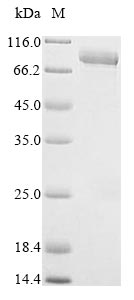The region for expressing recombinant Human LPO contains amino acids 81-712. This LPO protein is theoretically predicted to have a molecular weight of 76.6 kDa. Expression of this LPO protein is conducted in mammalian cell. The N-terminal 10xHis tag and C-terminal Myc tag was fused into the coding gene segment of LPO, making it easier to detect and purify the LPO recombinant protein in the later stages of expression and purification.
The human lactoperoxidase (LPO) is an enzyme belonging to the peroxidase family and is primarily found in secretory fluids such as milk, saliva, and tears. LPO plays a crucial role in innate immune defense mechanisms. It contributes to the antimicrobial activity of these fluids by catalyzing the oxidation of thiocyanate and iodide ions, producing reactive intermediates that possess antimicrobial properties. Additionally, LPO is involved in the generation of reactive oxygen species, contributing to the elimination of bacteria and other pathogens. Research on lactoperoxidase focuses on its role in host defense, its potential applications in food preservation, and its relevance to human health.






